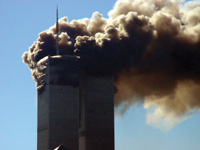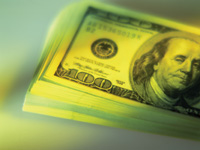Rallies in Domestic Markets are Driven by Surging Overseas Stats
Back to Contents of Issue: December 2003
|
|
|
|
by Darrel Whitten |
|
|
Since the US recession supposedly ended in November 2001, economists have been looking for a recovery. But they have been equally reluctant to give the "all clear" sign. The "shocks" of the last three years -- the September 11 terrorist attacks, the Iraq War and the Enron as well as other accounting scandals -- have made forecasters gun shy. Consequently, the US market has been climbing a wall of worries: The current rally has begun from the highest trailing price/earnings ratios on record, and the US has swung toward ballooning trade and fiscal deficits.
The dollar has already declined significantly, both nominally and on a trade-weighted basis. While this is ostensibly positive for corporate profits and US exports, too sharp a dollar fall would have foreign investors packing up their bags of money and going home, leaving the US in a pickle regarding its substantial deficit-funding needs. Bond yields have backed up sharply, and this could potentially threaten any recovery, particularly hitting durable goods and housing consumption. In addition, the budding recovery has not led to job creation so far. This could strangle any consumption-led recovery.
But it's beginning to look like stock prices were more right than wrong after all. The US and global economies increasingly look like they are turning the corner. Despite much hand-wringing by cautious investors, the economic numbers are coming through just when it seems the market rally needs them most, and the majority of the figures are consistently more surprising on the upside, which is typical in the early stages of a recovery.
The commodity-price rally continues
Gold prices rose 41 percent from late 2002 to March 2003, allegedly on global geopolitical tensions and the falling dollar. But even after bond yields reversed and stock prices surged, gold continued to rally. Numerous studies on the link between gold prices and inflation expectations show that gold has no particular significance for forecasting inflation, but it remains a leading indicator for other industrial commodity prices, whose rallies are another indication that a global economic recovery is under way.
The rally in industrial metals reflected the fact that by mid-August, reports were filtering out that US industrial output had recorded its biggest gain since January, marking the third increase in a row and pleasantly surprising consensus forecasts. By late August, economists were raising US growth forecasts for the third quarter to as high as 7 percent, or more than two times growth levels in the preceding quarter.
The Economic Cycle Research Institute's leading index hit a record high of 129.5 during the week of September 12. The index's growth rate, an annualized rate for the four-week moving average that evens out weekly fluctuations, has slowed somewhat in the latest reading, but the institute says that "we should be prepared for above trend US GDP growth for the next couple of quarters."
The US jobs surprise
At the same time, the Institute of Supply Management released numbers indicating that the service economy was expanding at its second-fastest pace this Autumn for its sixth consecutive monthly gain.
Anything that bolsters confidence in the US recovery helps to support the US dollar, which had been supported by a strong domestic economy, an inviting investment climate and competitive markets. If the US has actually abandoned its "strong-dollar policy" to stem criticism of the Bush administration from Congress and US manufacturers, it is playing with fire. This is because the policy, without the support of a strong domestic economy, is an emperor with no clothes.
But evidence that the recovery was beginning to generate an improved job market was seen as an inflection point for stable economic growth ahead, which helped alleviate concerns raised by the Group of Seven pronouncement. Gold, the mirror image of the US dollar of late, reflected the shift among currency traders.
But the specter of a dollar rout will continue to haunt the US market unless the US can get a handle on the renewed surge in deficits. It is widely recognized by the International Monetary Fund and domestic organizations like the National Association for Business Economics that the soaring US deficit will remain America's chief risk, although the threat is more relevant to US long-term growth than to this current recovery. The growing US dependency on foreign capital has not gone unnoticed by the larger capital providers. The front page of the Sunday Nikkei carried an article outlining the increasing US dependence on foreign capital to fund its deficits and its growing dependency on the corporate bond and stock markets. The foreign dependency for US treasuries has soared from under 20 percent in 1994 to 35.6 percent.
Of all the challenges US stocks continue to face, a falling dollar still represents the biggest potential risk.
Japan's economic surprises
The April-June GDP indicated annualized growth of 2.3 percent, and consumer spending actually rose despite consensus expectations for declines. Household spending rose for the first time in nine months. The jobless rate declined to 5.1 percent in August, and the Tokyo consumer confidence index also improved for the second consecutive month. Reflecting the improvement in business sentiment, the September tankan survey showed the diffusion index of business sentiment among large manufacturers at plus one, turning positive for the first time in two years and nine months. But the survey did not include reaction in the business community to the yen's renewed rise.
Mixed signals in the September Tankan
But most large manufacturers assumed that the dollar would average around JPY117.5 in the second half of the fiscal year, a level some JPY7 weaker than current average exchange rates. In addition, Japan's exports stopped growing in August, shrinking by 3.5 percent in volume. The industrial production index also sank 0.5 percent from the prior month, down for the first time in two months. Large manufacturers plan to expand capital spending this fiscal year, but they revised their spending forecasts slightly downward from the previous survey to an 11.1 percent increase.
Rising interest rates will also weigh on businesses, and many large corporations expect them to climb further. The tankan revealed that small and midsize firms are increasingly worried about a future increase in interest rates on loans. Additionally, companies share the view that they will face greater difficulty procuring funds, especially as financial institutions become less willing to extend loans in their push to clean up their own balance sheets.
Compared with large manufacturers, which are supported by strong exports, business sentiment is weak among non-manufacturers that are relatively dependent on domestic demand, with the index for the latter group standing at minus 13, unchanged from the previous survey. In particular, business sentiment among retailers and transportation firms deteriorated sharply due to slack personal spending and Japan's cool summer.
Why is all the foreign money pouring into Japan? The theory is that markets in the Western economies will remain in a "going nowhere" pattern in the coming years as there is a massive transfer of wealth to Asia. The dollar is due for a major secular correction that will reduce total returns on US assets to foreign investors.
Plus, Japan is showing all the characteristics of a secular bear market low and is priced relatively cheaper than Western markets. The Japanese market may now warrant an overweight position vis-a-vis global and international benchmarks.
In this cycle, foreign investors have been net buyers of Japanese equities for six consecutive months, making net purchases of JPY5.2 trillion between April and September, with August being the month of the highest net purchases: JPY1.301 trillion. This compares to the record of monthly net purchases of JPY1.75 trillion set in March 1999. The inrush of foreign funds has made Japan the best performer of the major countries in dollar terms for the calendar year to date, but it still lags behind others in terms of a 12-month performance, according to the Dow Jones dollar-denominated country indexes.
As far as purchase cycles go, foreign investors have (during the Heisei Malaise) been net buyers for up to 18 consecutive months, as was seen during the telecom-media-tech bubble in 1999 and 2000. But for all this newfound optimism, domestic investors -- including the proprietary trading desks of the brokerage firms -- have all been net sellers during this period.
In other words, there has been no net buying support at all from domestic investors, even though there is very active trading by individuals through online brokers. It's bracingly clear that domestic investors just aren't buying the foreign investors' bullish theories.
But neither the sharp backup in interest rates nor soaring equity prices appears to have drawn significant amounts of domestic funds from bonds into stocks. And the weakening dollar and rising domestic stock prices have failed to tempt domestic institutions into significantly shifting from dollar-denominated offshore investments and domestic bonds into domestic equities.
The continued upward pressure on the yen despite massive intervention by the central bank even after the Group of Seven pronouncement deeply worries Japanese investors and corporations with significant dollar exposure.
The smaller-cap stocks, particularly the Jasdaq listings, continue to record new highs. Active trading by individual investors supports Jasdaq.
In May 2003, we at J@pan Inc said that Japan's small caps were the sector of preference. Despite the skewed weighting of a few "large cap" companies in the Jasdaq indexes, small caps have so far lived up to our expectations. We're keeping our eyes peeled. @
|
|
Note: The function "email this page" is currently not supported for this page.


 HAVING SWALLOWED A GOOD deal of the US economic recovery story without a sizeable chunk of evidence, stock and bond investors were having some serious second thoughts. And with policy missteps aimed at getting China to devalue the yuan, the US dollar's renewed sell-off made investors nervous.
HAVING SWALLOWED A GOOD deal of the US economic recovery story without a sizeable chunk of evidence, stock and bond investors were having some serious second thoughts. And with policy missteps aimed at getting China to devalue the yuan, the US dollar's renewed sell-off made investors nervous.
 Three main issues that could derail Japan's budding recovery continue to bother domestic investors. First, investors fear that the strengthening of the yen cannot be contained by the interventions of the Bank of Japan in the currency markets. They also worry about a rise in interest rates being much faster than recovering corporate profits can absorb. And finally, they are concerned that business sentiment among non-manufacturers and smaller businesses might remain weak.
Three main issues that could derail Japan's budding recovery continue to bother domestic investors. First, investors fear that the strengthening of the yen cannot be contained by the interventions of the Bank of Japan in the currency markets. They also worry about a rise in interest rates being much faster than recovering corporate profits can absorb. And finally, they are concerned that business sentiment among non-manufacturers and smaller businesses might remain weak.



